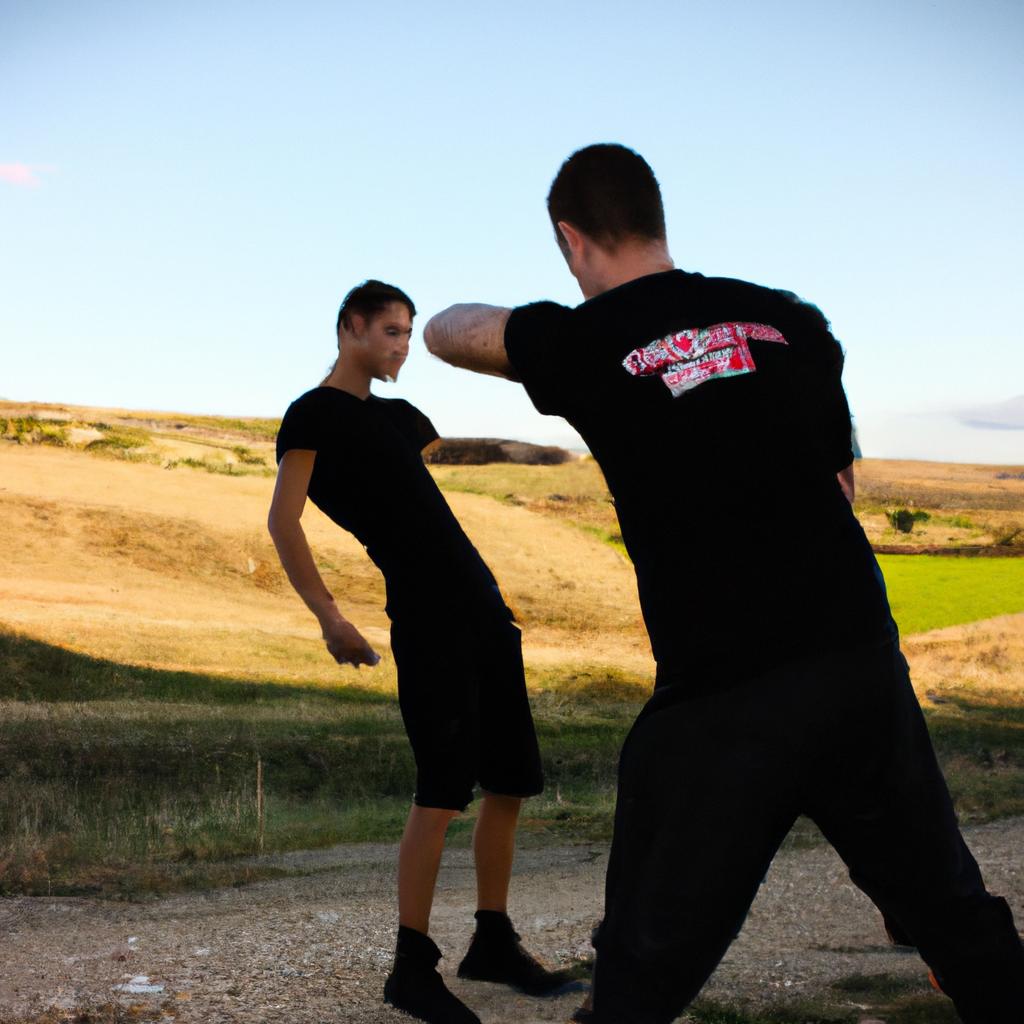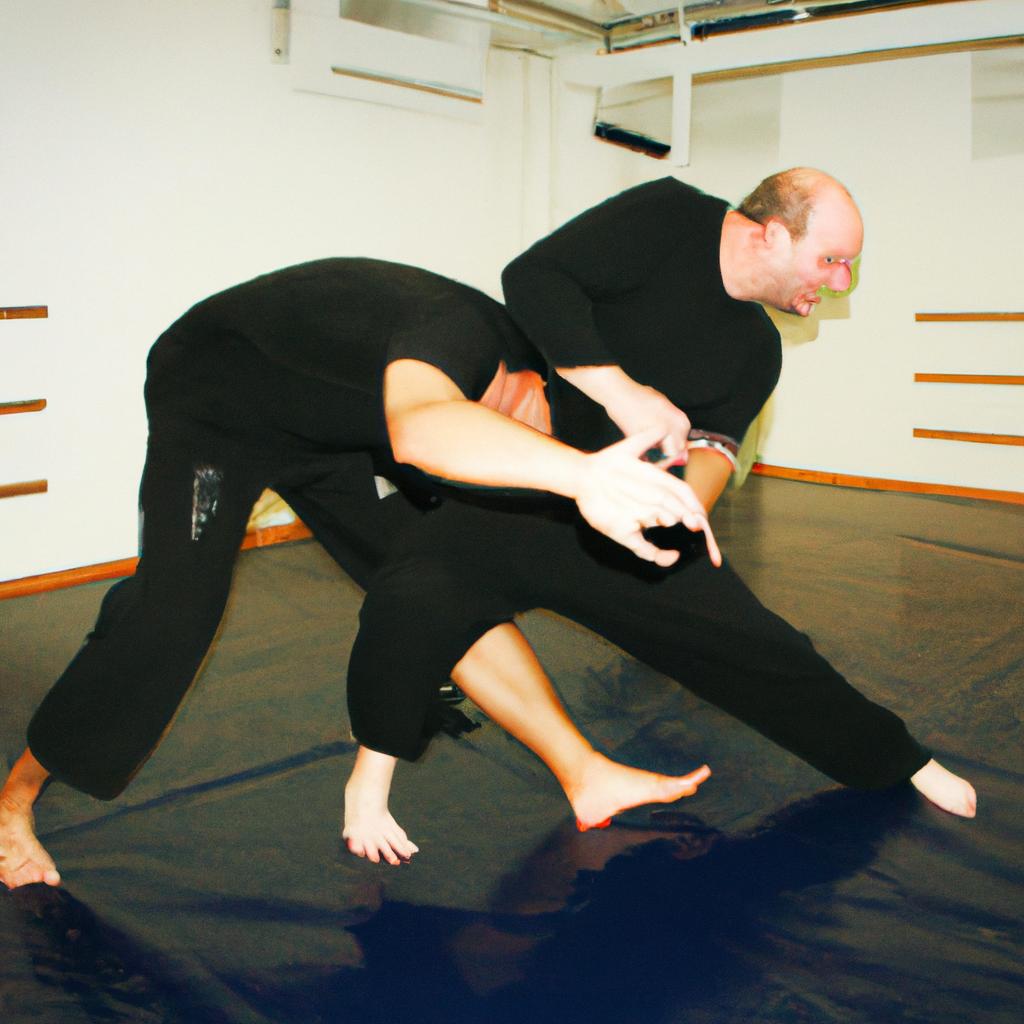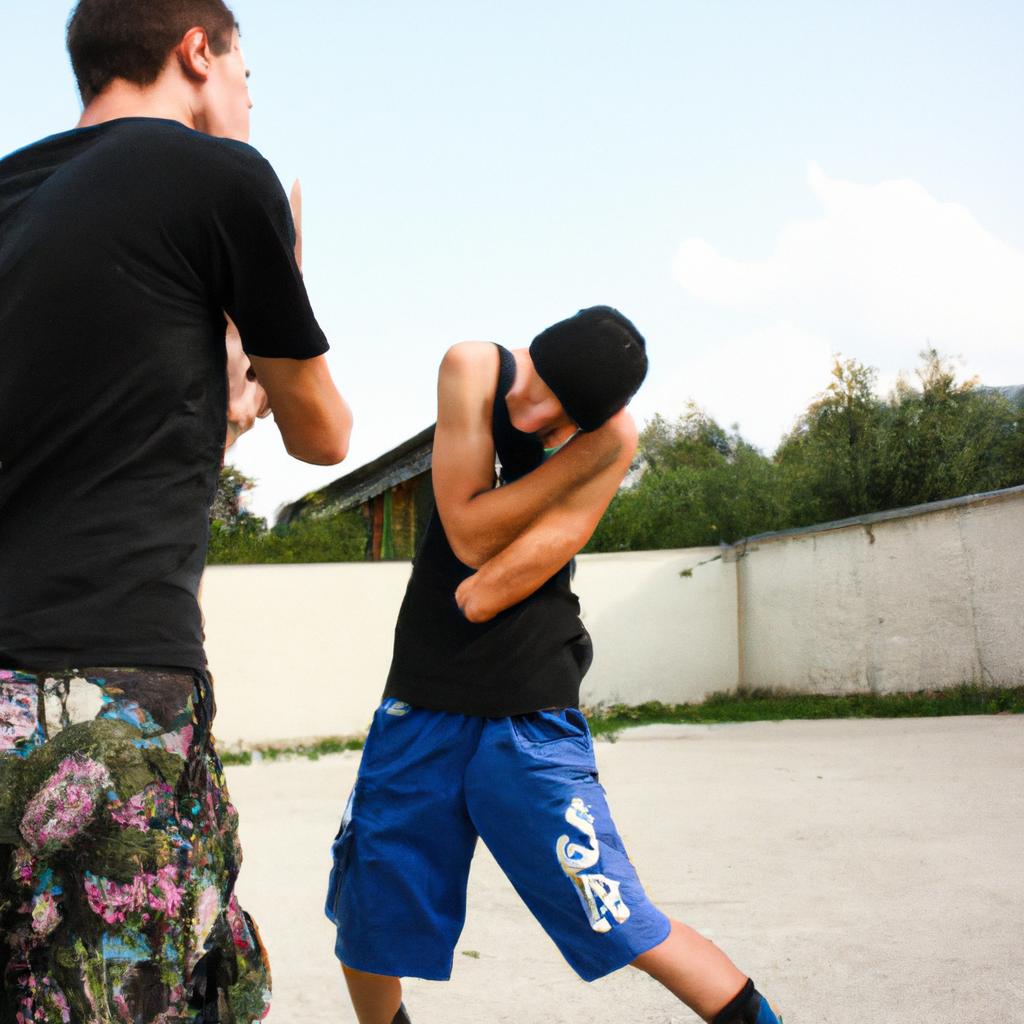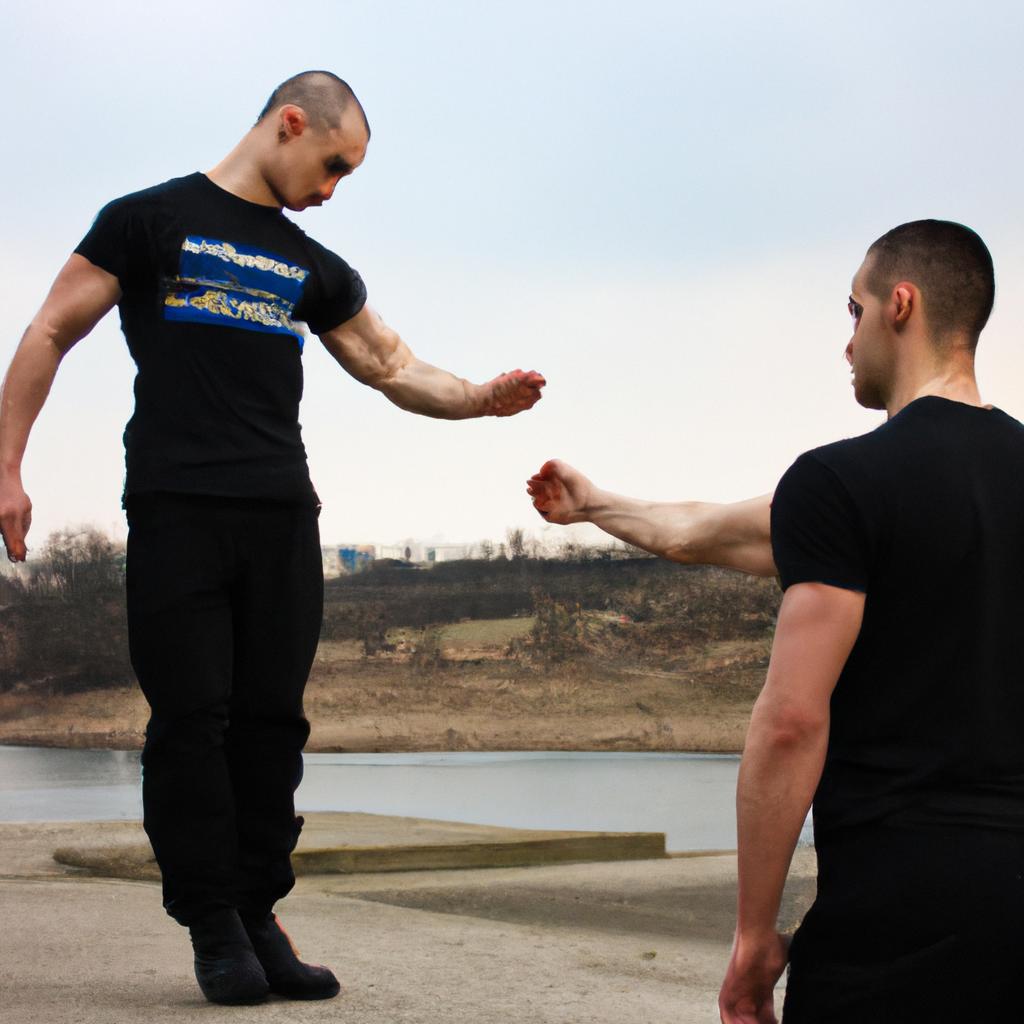In the intense and dynamic world of Mixed Martial Arts (MMA), fighters are constantly seeking new techniques to gain an edge over their opponents. One such technique that has gained popularity is the incorporation of weapons training, particularly through the utilization of Krav Maga techniques. The integration of Krav Maga into MMA not only enhances a fighter’s self-defense abilities but also provides them with a unique advantage in combat situations.
To illustrate the impact of incorporating Krav Maga into MMA, let us consider the hypothetical scenario of two skilled fighters facing off inside the octagon. Fighter A, trained solely in traditional MMA techniques, relies on his knowledge and proficiency in striking, grappling, and submission holds. On the other hand, Fighter B possesses a background in Krav Maga as well as MMA. As they engage in close-quarter combat, Fighter B skillfully transitions between strikes and weapon-assisted maneuvers derived from Krav Maga principles. This combination allows Fighter B to effectively use everyday objects as improvised weapons or seamlessly transition from unarmed combat to armed combat when necessary. Such tactical versatility gives Fighter B a distinct advantage over Fighter A by expanding their arsenal beyond conventional fighting methods alone.
The incorporation of weapons training derived from Krav Maga brings forth numerous benefits for MMA fighters. Firstly, it enhances their overall self-defense capabilities, allowing them to effectively defend themselves in real-life combat situations both inside and outside the octagon. By learning how to use weapons as extensions of their own bodies, they are better equipped to neutralize threats and leverage their surroundings to their advantage.
Secondly, incorporating Krav Maga techniques into MMA adds an element of surprise for fighters. The ability to seamlessly transition from unarmed combat to armed combat catches opponents off guard, giving the fighter with Krav Maga training a significant edge. This unpredictability can create opportunities for quick finishes or strategic advantages during a fight.
Furthermore, the integration of Krav Maga techniques instills a heightened sense of situational awareness in MMA fighters. They learn to assess their environment and identify potential objects that can be utilized as weapons. This increased awareness allows them to adapt quickly during fights and capitalize on any available resources.
Lastly, by incorporating weapons training derived from Krav Maga into MMA, fighters gain a unique skill set that sets them apart from their competitors. It showcases their versatility, adaptability, and willingness to explore different fighting styles. This diversity not only makes them more well-rounded fighters but also increases their marketability and appeal within the MMA community.
In conclusion, the incorporation of weapons training derived from Krav Maga into MMA provides numerous benefits for fighters. It enhances self-defense capabilities, adds an element of surprise, boosts situational awareness, and showcases versatility. As the world of MMA continues to evolve and become more competitive, embracing new techniques like those found in Krav Maga can give fighters a distinct advantage over their opponents.
Benefits of Weapons Training in MMA
Imagine a scenario where an MMA fighter finds themselves facing an opponent armed with a knife. In this critical moment, the ability to effectively defend oneself becomes paramount. This is where weapons training in Mixed Martial Arts (MMA) can provide invaluable benefits. By incorporating techniques from disciplines such as Krav Maga, fighters gain a unique advantage that enhances their overall skill set and prepares them for real-life combat situations.
One key benefit of weapons training in MMA is the development of increased situational awareness. When confronted with an armed assailant, it is crucial to recognize potential threats and react swiftly. Through weapons training, fighters learn how to assess their surroundings and identify potential dangers, enabling them to respond appropriately. This heightened level of awareness not only improves their ability to defend against weapon attacks but also carries over into unarmed combat scenarios.
Moreover, weapons training in MMA cultivates adaptability and versatility. The techniques learned through disciplines like Krav Maga equip fighters with skills that transcend specific weapon types and translate seamlessly between various combat contexts. Armed with this knowledge, athletes can confidently face opponents wielding different weapons or even engage in improvised weaponry encounters. Such flexibility allows fighters to stay one step ahead by adapting quickly to changing circumstances during intense matches or self-defense situations.
The impact of weapons training on mental resilience cannot be underestimated either. The intensity and focus required when dealing with potentially life-threatening situations develop mental fortitude within fighters. They become more composed under pressure, maintaining clarity of thought while executing precise defensive maneuvers. This psychological aspect plays a vital role not just in fighting but also in everyday life, empowering individuals with confidence and discipline beyond the confines of the octagon.
In summary, integrating weapons training into MMA provides numerous advantages for fighters’ overall performance both inside and outside the ring. With enhanced situational awareness, adaptability, versatility, and improved mental resilience, athletes are better equipped to handle dangerous confrontations involving weapons. In the following section, we will explore key principles of Krav Maga techniques and how they can be applied effectively in MMA scenarios.
- Increased confidence and self-assurance
- Enhanced personal safety and security
- Empowerment to protect oneself and others
- Greater peace of mind in potentially dangerous situations
| Benefits of Weapons Training in MMA |
|---|
| Improved situational awareness |
| Adaptability and versatility |
| Mental resilience |
Moving forward, let us delve into the key principles of Krav Maga techniques utilized within MMA combat settings.
Key Principles of Krav Maga Techniques
Building on the benefits of weapons training in MMA, let us now delve into the key principles that underpin Krav Maga techniques. By understanding these principles, athletes can effectively incorporate this form of self-defense into their arsenal and enhance their overall skill set.
Krav Maga is a practical martial art developed for real-world situations, emphasizing simplicity, efficiency, and adaptability. To grasp its essence, consider a hypothetical scenario where an MMA fighter encounters an armed assailant during a street altercation. The fighter’s ability to utilize Krav Maga techniques can be instrumental in neutralizing the threat quickly and efficiently while minimizing harm to themselves or others.
The effectiveness of Krav Maga lies in several core principles:
-
Simplicity: Krav Maga aims to simplify complex movements and techniques so they can be easily learned and applied under high-stress situations. This principle allows fighters to react swiftly without relying on intricate maneuvers that may require years of practice to master.
-
Economy of Motion: Efficiency is paramount in Krav Maga as practitioners seek to achieve maximum impact with minimal effort. Movements are designed to generate power from the body’s natural mechanics rather than relying solely on brute strength.
-
Retzev (Continuous Attack): In a real-life confrontation, it is crucial to maintain constant pressure on the opponent. Krav Maga encourages relentless aggression by promoting combinations of strikes, kicks, knees, and elbows intended to overwhelm adversaries and create opportunities for escape or control.
-
Adaptability: Unlike other traditional martial arts styles focused on adhering strictly to predetermined techniques, Krav Maga embraces adaptability based on situational context. It emphasizes improvisation and quick decision-making skills necessary when confronted with unpredictable scenarios.
To further illustrate the significance of these principles within Krav Maga training methods, consider the following table:
| Principle | Description |
|---|---|
| Simplicity | Minimizing complex techniques, enabling rapid learning and application in high-stress situations. |
| Economy of Motion | Maximizing efficiency by utilizing natural body mechanics and minimizing unnecessary movements. |
| Retzev (Continuous Attack) | Maintaining relentless aggression to overwhelm opponents and seek opportunities for control or escape. |
| Adaptability | Embracing flexibility and improvisation based on the situational context at hand. |
By adhering to these principles, MMA practitioners can supplement their existing skill set with Krav Maga techniques that are practical, effective, and adaptable.
Understanding the core principles of Krav Maga lays a solid foundation for exploring the types of weapons used within this discipline. Let us now examine various weapons commonly utilized in Krav Maga training scenarios without skipping a beat.
Types of Weapons Used in Krav Maga
Transitioning from the key principles of Krav Maga techniques, it is essential to delve into an exploration of the types of weapons used in this form of martial arts. By understanding these weapons and their applications, practitioners can develop a comprehensive skill set that prepares them for real-world self-defense scenarios.
One example of a commonly utilized weapon in Krav Maga is the tactical knife. This compact yet lethal tool enables fighters to inflict serious damage on opponents while maintaining agility and control. With proper training, individuals can learn various techniques such as slashes, stabs, and thrusts to maximize the effectiveness of this weapon.
- Weapons provide an added layer of protection: In dangerous situations where attackers may be armed, having knowledge about how to handle different weapons empowers individuals with greater confidence and options for defending themselves.
- Enhances overall combat skills: Learning how to use weapons effectively not only improves proficiency in hand-to-hand combat but also enhances one’s ability to assess potential threats and make split-second decisions.
- Develops mental resilience: Training with weapons requires focus, discipline, and mental fortitude. The process instills valuable attributes such as situational awareness and adaptability under pressure.
- Promotes physical fitness: Incorporating weapons training into MMA workouts provides a unique challenge that engages multiple muscle groups, improving strength, coordination, and flexibility.
Additionally, let us examine a table showcasing some common types of weapons used in Krav Maga:
| Weapon | Description | Application |
|---|---|---|
| Tactical Knife | Small blade designed for concealment and quick deployment | Close-quarters combat |
| Baton | Extendable or solid stick-like object | Striking techniques |
| Improvised Weapons | Everyday objects repurposed for self-defense | Utilizing what is readily available for defense |
| Firearms | Handguns or rifles | Used when facing potentially armed assailants |
As an integrated part of MMA, weapons training in Krav Maga serves the purpose of expanding a fighter’s capabilities and preparing them for various scenarios. By understanding different types of weapons and their applications, practitioners can effectively integrate these skills into their overall martial arts practice.
Transitioning to the subsequent section on the integration of weapons training in MMA, it is crucial to explore how this incorporation enhances fighters’ versatility and self-defense abilities without compromising their existing skill set.
Integration of Weapons Training in MMA
Exploring the Application of Krav Maga Techniques in MMA
To highlight the effectiveness and practicality of incorporating Krav Maga techniques into MMA, let’s consider a hypothetical scenario. Imagine two fighters facing each other in the octagon – one trained solely in traditional MMA, while the other has received extensive training in both MMA and Krav Maga. As they engage in combat, it becomes evident how the integration of Krav Maga techniques enhances their defensive capabilities and provides an edge against opponents.
Krav Maga emphasizes the use of weapons as part of its comprehensive self-defense system. By introducing weapon training into MMA, fighters can further diversify their skill sets and adapt to various real-life situations where weapons may be involved. Here are some key aspects to understand about integrating weapon training from Krav Maga into MMA:
-
Situational awareness: Training with weapons not only teaches fighters how to defend themselves but also enhances their situational awareness skills. Understanding different types of weapons used in Krav Maga helps athletes anticipate potential threats during a fight or even outside the ring.
-
Effective striking techniques: Incorporating weapon training allows for more effective striking techniques during fights. Fighters learn how to leverage objects such as sticks or knives to deliver powerful strikes that can disable opponents quickly.
-
Improved defense strategies: Weapons training equips fighters with enhanced defensive strategies aimed at disarming adversaries effectively. By understanding how attackers might employ weapons, athletes can develop countermeasures that neutralize threats efficiently.
-
Psychological advantage: The mere presence of a weapon can intimidate opponents, providing psychological advantages that benefit those who have integrated weapon training into their martial arts repertoire.
Furthermore, by combining these elements with existing MMA skills, athletes gain a competitive edge over opponents lacking similar diversity in their fighting styles.
| Advantages of Integrating Weapon Training in MMA |
|---|
| 1 |
| 2 |
| 3 |
| 4 |
Incorporating Krav Maga weapon training into MMA introduces a new dimension to fighters’ skill sets, enabling them to overcome challenging situations both inside and outside the octagon. By integrating these techniques, athletes can further enhance their overall performance and increase their chances of success in combat. In the following section, we will delve into specific training drills that focus on mastering weapons techniques in order to provide practical guidance for aspiring fighters seeking to incorporate this aspect into their arsenal.
Training Drills for Weapons Techniques
Exploring Krav Maga Techniques for Weapons Training in MMA
To understand the significance of incorporating weapons training into Mixed Martial Arts (MMA), let us consider a hypothetical scenario. Imagine an MMA fighter facing off against an opponent who wields a knife during a match. Without proper knowledge and training in weapon defense techniques, the consequences could be grave. This highlights the importance of integrating weapons training into MMA, as it equips fighters with effective strategies to neutralize potential threats.
Krav Maga, an Israeli martial art known for its practicality and efficiency, offers valuable techniques that can enhance a fighter’s ability to handle various types of weapons. By incorporating elements of Krav Maga into their training regimen, MMA practitioners gain several advantages:
- Versatility: Krav Maga provides fighters with the skills necessary to defend against different types of weapons such as knives, sticks, or firearms.
- Situational Awareness: The training emphasizes situational awareness, enabling fighters to identify potential threats and react swiftly in real-world scenarios.
- Effective Strikes: Techniques derived from Krav Maga focus on powerful strikes aimed at vital targets, maximizing impact and incapacitating opponents quickly.
- Adaptability: Due to its emphasis on realistic self-defense situations, Krav Maga techniques can be seamlessly integrated into existing MMA practices.
Let us delve deeper into these benefits by exploring specific examples through a table displaying some essential weapon defense techniques taught in Krav Maga:
| Technique | Description | Example Scenario |
|---|---|---|
| Knife Defense | Teaches how to disarm attackers wielding knives safely and effectively | A fighter successfully neutralizing a knife-wielding assailant |
| Stick Defense | Provides methods for defending against attacks using sticks or clubs | A practitioner blocking strikes from an opponent armed with a stick |
| Firearm Disarming | Focuses on disarming techniques for defending against opponents wielding firearms | A fighter successfully removing a firearm from an attacker’s possession |
| Improvised Weapons | Equips fighters with the ability to utilize common objects as weapons in self-defense situations | A practitioner using a nearby chair to fend off an armed assailant |
In conclusion, integrating Krav Maga techniques into MMA training allows fighters to develop crucial skills needed for effective weapon defense. By enhancing versatility, situational awareness, striking capabilities, and adaptability, practitioners can better handle potential threats involving various weapons.
Safety Considerations in Weapons Training
[Write transition sentence here]
Safety Considerations in Weapons Training
In the world of mixed martial arts (MMA), incorporating weapons training can provide fighters with a unique set of skills and an advantage in combat situations. One effective discipline often used in MMA is Krav Maga, which focuses on practical self-defense techniques. Building upon the foundation of basic weapon handling, various training drills are employed to enhance proficiency and adaptability.
To illustrate the effectiveness of these drills, consider a hypothetical scenario where an MMA fighter named Alex finds themselves confronted by an assailant wielding a knife during a street altercation. Through their extensive weapons training using Krav Maga techniques, Alex is able to quickly assess the situation and efficiently neutralize the threat while minimizing harm to themselves or others nearby. This example showcases how dedicated practice and exposure to different training drills can empower individuals to effectively respond under high-pressure circumstances.
When engaging in weapons training within the realm of MMA, several key considerations come into play. These include:
- Safety precautions: Given the inherent risks associated with working with weapons, strict safety protocols must be followed at all times. Protective gear such as padded gloves, goggles, and mouthguards should be worn during training sessions.
- Controlled environments: Conducting weapons drills in controlled environments minimizes potential hazards and allows participants to focus solely on developing their technical skills without unnecessary distractions.
- Progressive skill development: Training drills should be structured in a progressive manner, starting from basic movements and gradually increasing complexity over time. This approach ensures that practitioners develop solid foundations before moving onto more advanced techniques.
- Realistic scenarios: Simulating real-life scenarios through role-playing exercises helps fighters apply their learned weapon techniques in practical contexts, preparing them for unpredictable encounters.
The table below provides examples of some commonly practiced Krav Maga weapons training drills:
| Drill | Objective | Equipment Required |
|---|---|---|
| Knife disarmament | To neutralize a knife-wielding attacker | Training knives, protective gear |
| Stick defense | To defend against an opponent armed with a stick | Sticks, protective gear |
| Gun retention | To maintain control over a firearm in close quarters combat | Training guns, holsters |
| Improvised weapons | To utilize everyday objects as defensive tools | Various household items |
By incorporating these drills and following the principles of Krav Maga within their training regimens, MMA fighters can enhance their overall skillset and be better equipped to handle potential weapon-based threats. It is crucial to remember that the ultimate goal of weapons training in MMA is not aggression or violence but rather self-defense and personal safety.
In summary, the integration of weapons training using Krav Maga techniques into the world of MMA offers fighters valuable skills for real-life situations. By engaging in various drills and adhering to strict safety measures, practitioners can develop proficiency in handling different types of weapons. The hypothetical scenario presented above demonstrates how this specialized training can empower individuals to effectively respond when faced with potentially dangerous encounters.




